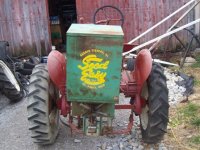I have to agree with Sixdogs on the frost seeding. I've been using it for 20 years on my hay field, and horse pastures, in fact. it's almost time to do that here in Ohio. I plan to do a light seeding on my pastures myself. I use one of the old pto driven Garber Seed Easy spreaders. You can usually find them
on ebay for less than $100. I bought one, like this one pictured below at an auction for $20. Best $20 I ever spent. Bolts on the draw bar, and PTO shaft is a piece of straight radiator hose. It holds approx. 15 lbs. of seed. It's best to find one with the seeding rate settings decal on it. Most are still there, if it's been taken care of. The company may still have new one's if it's not there. The best time to do it here, is the last two weeks of Feb., or the first two weeks of March, when the ground is going through the freeze/thaw cycles, and the top surface honeycombs. You're basically mimicking Mother Nature, when grasses/plants drop their seeds. The honeycomb effect, opening and closing in the freeze/thaw cycle,will pull the seed into the ground.
I have to agree with the sub-soiling also. I did mine I'm thinking 4 years ago. I have the one pasture that has a slight bowl to it in an area, just before it breaks downhill. I made 4-5 passes on it back then, and even after this last few days of heavy rains here in this saturated ground, the water disappeared within an hour. So I'm well satisfied it is still working.
I also have to agree with the taking of soil tests, and get your ground up to snuff, probably mainly on the lime. In reality, you don't want a lush pasture for your horses, especially in the Spring or, you're likely to have issues with Founder. Lush Spring grass will have a protein content of 21%. If the horse are turned out on it, to eat at their leisure, and gorge themselves, Founder is a good possibility. This can also happen after a period of summer drought, then early Fall rains from one of the hurricanes out of the South bringing it back to the lush stage.
Personally, I had 4 horses on approx. 2 acres of pasture, now 3. Yes, they keep it ate down pretty close, but I also supplement with hay. I make my own, so there was always enough 2nd, or 3rd cutting to feed, and just enough that they'll clean it up, and not waste it. If you buy your hay, that may not work for you, but if you have one founder, it can even get more costly, and you'll be feeding hay for 6-8 weeks anyway to get them through it. Plus walking them 2 miles, twice a day. Been there, done that 5 years ago, when I had 1 pretty bad with founder, and one not so serious, but still meant walking each 2 miles, morning and evening. My easy out was to buy a good used horse walker, and let it do the work for me. 30 minutes morning, and evening did the trick, but was still over an hour + of my day to do that. It's kinda' one of those pay me now, or pay me later deals with either having a so-so pasture, or a nice pretty lush one.
One other tool I have I use, is a 6' plug type aerator, that has spoons that take plugs out. It definitely helps loosen up the pasture surface. I even run it in my hay field every 2-3 years,depending on how damp the soil was when I've made hay. These last couple of years hay was made when the ground was slightly dampish, and was compacted with that many trips over the field with hay making equipment. Mid April is usually when the ground is suitable to aerate. Somewhat dry, but damp enough for the aerator to penetrate. The great thing is, you can run with it, as fast as it is comfortable to ride the tractor.
This is just my personal experience with horses. They are definitely not like cattle or other livestock. Lush pastures are really not a good thing. Mine will sustain 75% of their needs, while not over indulging, and 25% comes from feeding hay, to take some stress off the pasture. I also have my pastures in 2 sections. The one is the sacrificial pasture, that takes the beating in early Spring, while saving the other for later grazing. I won't turn them out on the second pasture until around Memorial Day. Up to that point, I keep it mowed, or make first cutting hay off of it, just so they won't get that lush high protein grass. And clip it about a week before turning them out on it, so they won't get too much.
Just my opinion, take it for what it's worth...

Don't know if that'd work, but just an idea.
